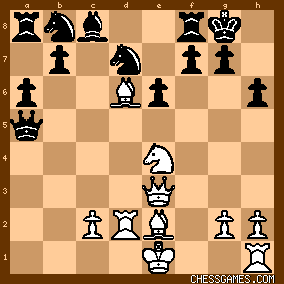|
This is a collection of important games in the Najdorf 6. Bg5 variation, with an emphasis on recent games. After 1. e4 c5 2. Nf3 d6 3. d4 cxd4 4. Nxd4 Nf6 5. Nc3 a6 6. Bg5 e6 7. f4 
click for larger view Black's main moves are:-
A. 7. ...Qb6 (Poisoned Pawn)
B. 7. ...Be7
C. 7. ...Nbd7
D. 7. ...Qc7
E. 7. ...b5 (Polugaevsky Variation)
<***** A. 7. ...Qb6 *****> The poisoned pawn variation is extremely sharp. It has been exhaustively analysed by both man and machine. 10. f5 was thought to be the critical line and the verdict was that it was a draw with best play. See F Vallejo Pons vs Kasparov, 2004 apparently representing best play by both sides (but NB 20. Bd3!? Grischuk vs Anand, 2009). However, the poisoned pawn has attracted renewed attention, with White trying for an advantage in the line 8 Qd2 Qxb2 9 Rb1 Qa3 10 e5!? de 11 fe Nfd7 12 Ne4 h6 13 Bh4 Qxa2 14 Rd1!? Qd5 where White will invest two pawns for a lasting attack: 
click for larger viewBest play seems to continue:
15. Qe3 Qxe5 16. Be2 Bc5! 17. Bg3 Bxd4 18. Rxd4 Qa5+ 19. Rd2 O-O 20. Bd6 Resulting in this position, where ...f5 (!), ... Rd8 (?!), ...Nc6 (!?) are some possible options for Black. Black seems to be doing OK now in this line.

click for larger viewSome recent games in this critical line:
Motylev vs Anand, 2007
Anand vs Van Wely, 2007
E Berg vs E Najer, 2007
E Najer vs Nepomniachtchi, 2008 White can decline to enter into the poisoned pawn variation with 8. Nb3 (a line that Kamsky, in particular, is fond of), but it is not obvious that White can set Black serious problems in that line. 8. Qd3!? is an interesting sideline.
<***** B. 7. ...Be7 *****> 7. ...Be7 is a principled response which has, again, been very heavily analysed and the mainlines are long and well-established with a major branch at White's move 10 7. ...Be7 8 Qf3 Qc7 9 O-O-O Nbd7

click for larger viewB1 10 g4 b5 11 Bxf6 Nxf6 12 g5 Nd7 13 f5 Nc5 (13. ...Bxg5+!?) B2 10 Bd3 b5 11 Rhe1 Bb7 12 Qg3 (12 Nd5!?) b4! 13 Nd5 exd5 14 e5!? There are many transpositional possibilities in particular between lines B, C and D. <***** C. 7. ...Nbd7 *****> 7. ...Nbd7, is another principled response. Black may want to leave the dark square bishop where it is and not castle. This is the line which Gelfand has always used against 6. Bg5 with very stable results (search "gelfand b96"). Lots of interesting games in this line, including possibilities for White to sac a piece on b5 or d5, to exploit Black's king position. A good choice if both players want a fight, which is reflected in the large number of decisive games. 1. e4 c5 2. Nf3 d6 3. d4 cxd4 4. Nxd4 Nf6 5. Nc3 a6 6. Bg5 e6 7. f4 Nbd7 8. Qf3 Qc7 9. O-O-O b5 is the main starting tabiya 
click for larger viewOpening Explorer and play can continue 10. Bd3 Bb7 11. Rhe1

click for larger viewOne critical line where black needs a solution is: 11. ...Be7 12. Qg3 b4 13. Nd5! exd5 14. exd5 Kd8 15. Nc6+! Bxc6 16. dxc6 
click for larger view 8. Qe2 is now a major line which has taken off in recent years, and may now even be considered the main line 
click for larger viewOpening Explorer <***** E. 7. ...b5 *****> This is the Polugaevsky variation which is even more wild than the poisoned pawn. Black temporarily gives up a piece: 1. e4 c5 2. Nf3 d6 3. d4 cxd4 4. Nxd4 Nf6 5. Nc3 a6 6. Bg5 e6 7. f4 b5 8. e5 dxe5 9. fxe5 Qc7! 10. exf6 Qe5+ 11. Be2 Qxg5 reaching this position, which is the first major branch 
click for larger view
Opening Explorer where white can play either 12. O-O or 12. Qd3. White is thought to be doing well here and the Polugaevsky generally has a reputation of not being sound, although it's still occasionally seen at high(ish) levels. Anyone interested in these lines, should check out KingG's excellent game collection as well - Game Collection: Sicilian Najdorf 6.Bg5
| 


